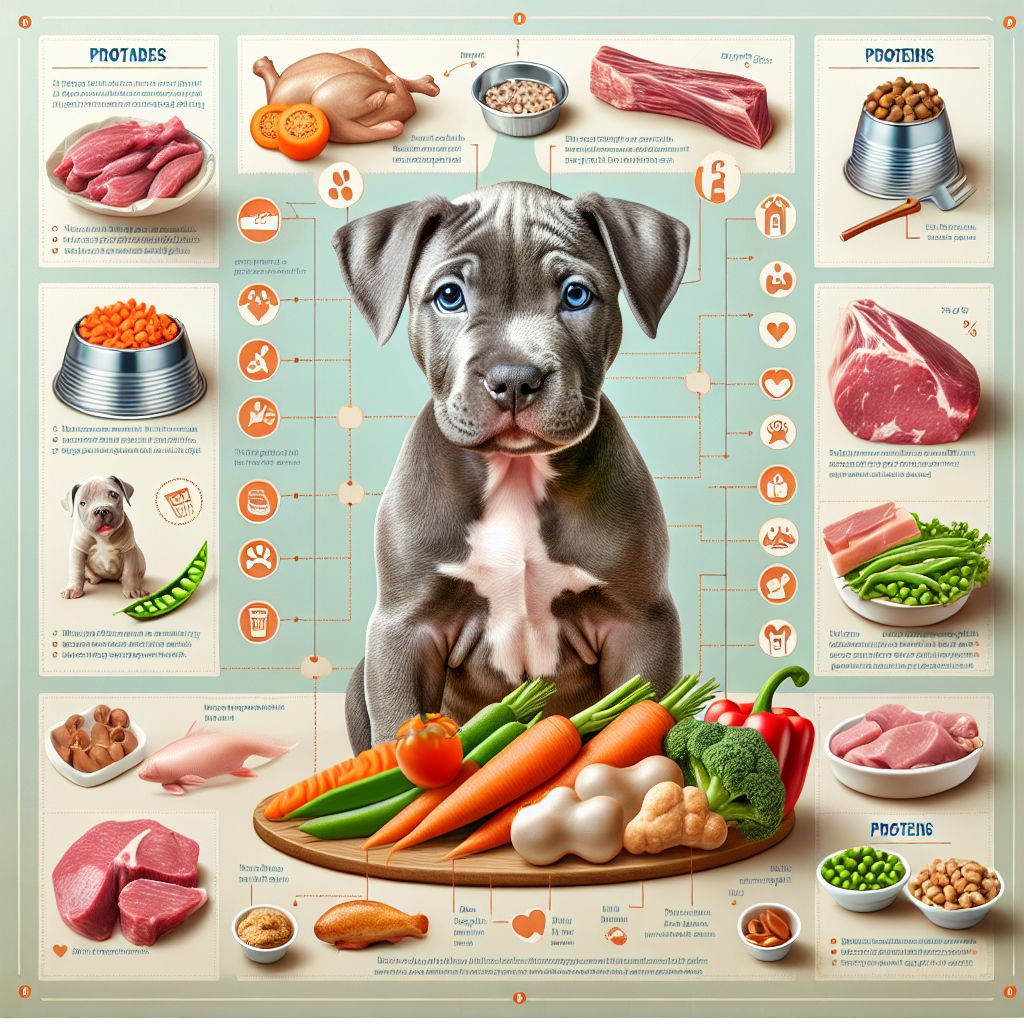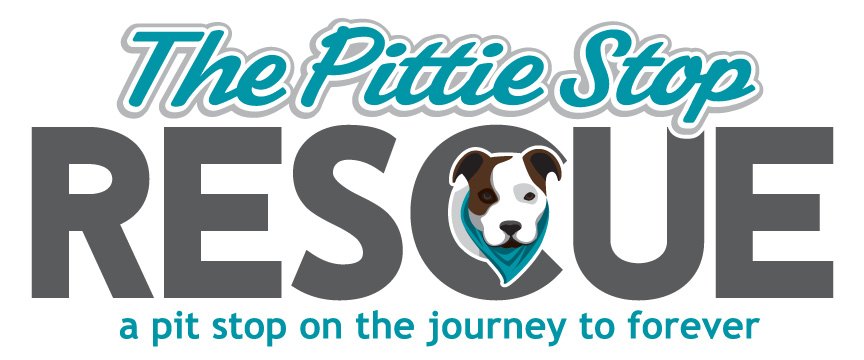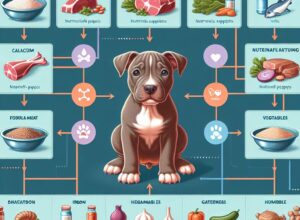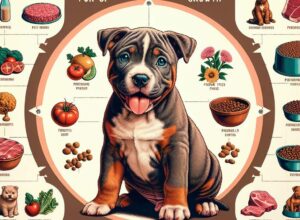
Key Takeaways
- A pitbull puppy’s diet should be high in protein and balanced with essential fatty acids and carbohydrates.
- Low-fat diets are crucial for puppies with specific health needs but should be carefully balanced to ensure proper growth.
- Portion control and a consistent feeding schedule are key to managing your pitbull puppy’s energy levels and weight.
- Commercial low-fat dog foods can be convenient, but it’s important to check for high-quality ingredients.
- Gradual transition to a low-fat diet is essential to avoid digestive upset.
Fueling Your Pitbull Puppy with the Right Nutrients
When it comes to feeding your pitbull puppy, think of their diet as the fuel for a powerhouse. These pups are full of energy and need the right balance of nutrients to grow strong and healthy. You wouldn’t put low-grade fuel in a high-performance engine, and the same goes for your growing pitbull. They need high-quality, nutrient-dense food that will support their development and keep them romping and playing.
Most importantly, protein is the cornerstone of a pitbull puppy’s diet. It’s what helps them build those strong muscles and keeps their energy levels up. But, remember, not all proteins are created equal. You’ll want to aim for whole meats like chicken, beef, or fish as the primary source in their diet.
The Low-Down on Low-Fat: A Guideline for Puppy Diets
While low-fat diets are often associated with weight management in adult dogs, they can also be necessary for puppies with specific health conditions. However, because fat is a critical source of energy for growing dogs, any reduction must be done with careful consideration.
Before you consider a low-fat diet for your pitbull puppy, consult with a veterinarian. They can help determine if it’s necessary and guide you on how to balance it correctly. If your vet does recommend a low-fat diet, it’s usually because they want to ensure your puppy doesn’t grow too quickly, which can lead to joint problems, or because your pup has a health condition that requires it.
Therefore, if you’re advised to go low-fat, you’ll need to be vigilant about reading labels and understanding what goes into your puppy’s food. You’ll want to look for diets that are not only low in fat but also complete and balanced to support your puppy’s growth and development.
Key Components of a Low-Fat Diet for Pitbull Puppies
Selecting Quality Proteins
When you’re looking at low-fat options, the protein source becomes even more critical. You’ll want to ensure that the food you choose has a high-quality protein listed as the first ingredient. This means it should be a recognizable meat source, not a by-product or meal. Quality proteins provide the amino acids necessary for your pitbull puppy’s muscle development without the extra fat that they might not need.
Incorporating Essential Fatty Acids
Even in a low-fat diet, some fats are essential. Your pitbull puppy still needs omega-3 and omega-6 fatty acids to support their brain development, skin health, and coat shine. These can be found in ingredients like fish oil, flaxseed, and canola oil. Just because the diet is low in fat doesn’t mean it should be devoid of these crucial nutrients.
Understanding the Role of Carbohydrates
Carbohydrates are often misunderstood in the world of dog nutrition. While they’re not as critical as protein or fat, they do serve as an additional energy source. For a pitbull puppy on a low-fat diet, carbs can help make up some of the energy deficit that the reduced fat content creates. Look for whole grains or complex carbohydrates like sweet potatoes, which provide energy and dietary fiber.
Determining the Perfect Portion Size
Portion size can make or break a diet plan, especially for a growing pitbull puppy. Overfeeding can lead to obesity and related health issues, while underfeeding can hinder their development. The perfect portion size depends on your puppy’s age, weight, and activity level. As a general rule, puppies need about twice as many calories per pound of body weight as an adult dog. But remember, these are just guidelines. Keep an eye on your puppy’s body condition and adjust portions accordingly.
Establishing a Feeding Schedule
Consistency is key when it comes to feeding your pitbull puppy. A regular feeding schedule helps regulate their metabolism and prevents overeating. Aim to feed your puppy three to four times a day. As they grow, you can gradually reduce this to twice a day. This routine doesn’t just help with digestion; it also sets a pattern for bathroom breaks, aiding in potty training.
Now, it’s not just about when they eat, but also how they eat. Make mealtime a calm affair. A quiet environment can prevent your puppy from eating too quickly, which can cause digestive issues.
And here’s a little tip: after mealtime, give your puppy some quiet time. A bit of rest after eating is good for digestion and helps prevent conditions like bloat, which can be serious for large breed puppies.
- Feed your pitbull puppy three to four times a day when they’re young.
- Reduce feeding to twice a day as they mature.
- Keep mealtime calm and quiet to encourage proper eating habits.
- Allow for some rest after eating to aid digestion and prevent bloat.
Importance of Hydration in Puppies’ Diets
Hydration is just as important as food for your pitbull puppy. Fresh, clean water should always be available. It aids in digestion, helps regulate body temperature, and is essential for overall health. Monitor your puppy to ensure they’re drinking enough, especially after playtime or exercise.
Dehydration in puppies can be dangerous, so if you notice your puppy is drinking less, it could be a sign of illness, and you should consult your vet. Besides that, water intake can vary depending on the diet. If you’re feeding dry kibble, your puppy may need more water than if they’re on a wet or raw food diet.
Special Diets and Considerations for Active Pitbull Puppies
Active pitbull puppies might need more calories than their less active counterparts. If your pitbull puppy is a little dynamo, burning off energy with vigorous play and exercise, they’ll need a diet that can keep up with them. This doesn’t necessarily mean more fat; it means a well-balanced diet that’s higher in calories and rich in nutrients to support their activity level.
Supplements to Enhance Canine Vitality
Even the best diets can sometimes fall short of providing every nutrient in the exact amounts your pitbull puppy might need. Supplements can help bridge this gap. For instance, glucosamine and chondroitin supplements are often recommended for supporting joint health, especially in breeds prone to hip dysplasia, like pitbulls.
Omega-3 supplements, derived from fish oils, are fantastic for promoting a shiny coat and healthy skin. They also support brain development, which is crucial during your puppy’s formative months. But before adding any supplements to your puppy’s diet, it’s important to consult with a vet to ensure they’re necessary and safe.
Here’s the bottom line: supplements can be beneficial, but they should never replace a balanced diet.
Adjusting Diet with Exercise Intensity
If your pitbull puppy is especially active, you may need to adjust their diet accordingly. More exercise means they’ll need more energy, and while you want to keep the fat content in check, you can increase their calorie intake through proteins and complex carbohydrates. This ensures they have the fuel they need without the risk of unnecessary weight gain.
Recognizing and Managing Food Allergies and Sensitivities
- Watch for signs of allergies, such as itching, digestive upset, or ear infections.
- Consult with your vet if you suspect a food allergy or sensitivity.
- A limited ingredient diet might be necessary to identify the allergen.
- Once identified, avoid the triggering ingredient and seek alternative nutrient sources.
Food allergies and sensitivities can affect any dog, and pitbull puppies are no exception. If you notice symptoms like chronic itching, ear infections, or digestive upset, it could be a reaction to something in their diet. The best course of action is to consult with your vet. They might suggest an elimination diet, which involves feeding a limited ingredient diet to identify the allergen. Once the culprit is found, you’ll need to avoid it and find alternative ways to meet your puppy’s nutritional needs.
Remember, it’s all about creating a diet that works for your individual puppy. What’s right for one might not be right for another, so it’s important to stay observant and willing to adjust as needed.
- Keep an eye out for signs of food allergies and consult your vet for a proper diagnosis and diet adjustment.
- Active pitbull puppies may require a diet higher in calories but still balanced and low in fat.
- Supplements like glucosamine and omega-3 can be beneficial, but should never replace a well-rounded diet.
- Transitioning to a low-fat diet should be done gradually to avoid digestive issues.
- Always ensure your pitbull puppy has access to clean, fresh water, as hydration is essential.
Home-Cooked vs. Store-Bought: Diet Options for Your Puppy
Deciding between home-cooked meals and store-bought dog food is a big decision. Home-cooked meals allow you to control every ingredient, ensuring that your pitbull puppy is getting exactly what they need without any unnecessary fillers or additives. However, creating a balanced diet at home requires a lot of knowledge and time.
On the other hand, high-quality commercial dog foods are formulated to meet all of your puppy’s nutritional needs and are a convenient option for many pet parents. When selecting a store-bought food, look for brands that use whole food ingredients and have a good reputation for quality. Avoid foods with artificial colors, flavors, or preservatives, as these can be harmful to your puppy’s health.
Whether you choose home-cooked or store-bought, the most important thing is that the diet is tailored to your pitbull puppy’s specific needs, especially if they require a low-fat diet. Always consult with a veterinarian before making significant changes to your puppy’s diet.
Evaluating Commercial Low-Fat Dog Foods
When you’re browsing the aisles for a commercial low-fat dog food, don’t just look at the fat content. The overall nutritional profile is crucial. Ensure the food meets AAFCO standards for a complete and balanced diet for puppies. Check the ingredient list for real meat as the first ingredient, and avoid those with excessive fillers like corn or soy.
Remember, a low-fat label doesn’t automatically mean it’s a healthier option for your pitbull puppy. It’s the quality of the ingredients and the balance of nutrients that truly matter.
Recipe Ideas for Home-Cooked, Low-Fat Meals
If you decide to go the home-cooked route, here are a couple of recipe ideas to get you started:
- A lean turkey and vegetable stew with brown rice, rich in protein and fiber while keeping the fat content low.
- A fish-based meal with sweet potatoes and green beans, offering omega-3 fatty acids and complex carbs for energy.
Always discuss these recipes with your vet to ensure they’re appropriate for your puppy’s dietary needs. They may suggest adding a multivitamin or other supplements to make sure your home-cooked meals are nutritionally complete.
Transitioning to a Low-Fat Diet Safely
If you need to switch your pitbull puppy to a low-fat diet, do it gradually. Start by mixing a small amount of the new food with their current diet. Slowly increase the proportion of new food over the course of a week or two. This slow transition helps prevent digestive upset and gives your puppy time to adjust to the new flavors and textures.
Watch your puppy’s reaction to the new diet closely. If they experience any digestive issues or don’t seem to enjoy their new food, consult your vet. They may have suggestions for alternative foods or supplements to make the transition smoother.
Nutrition Plans Tailored to Growing Pitbull Puppies
Understanding Your Pitbull Puppy’s Nutritional Needs
Your pitbull puppy’s nutritional needs are unique. They require a diet that’s rich in protein to support their rapid muscle development, as well as fats and carbohydrates for energy. However, if they have health issues that necessitate a low-fat diet, it’s essential to ensure that their food still contains enough calories and nutrients to support their growth.
Every pitbull puppy is different, and there’s no one-size-fits-all approach to nutrition. Regular check-ups with your vet are the best way to ensure that your puppy’s diet is on track. They can provide personalized recommendations based on your puppy’s health, weight, and activity level.
Long-Term Diet Strategy for a Healthy Adult Pitbull
As your pitbull puppy grows, their dietary needs will change. Transitioning to an adult dog food should happen around 12 to 18 months of age, depending on their size and development. An adult pitbull’s diet should still be high in protein but can have a moderate amount of fat, as long as it’s the healthy kind—think fish oils and flaxseeds, not animal fats from by-products. For more detailed guidance, consider this nutrition guide tailored for a healthy 50 lb pitbull puppy transitioning into adulthood.
Keep in mind that as your pitbull ages, their activity level may decrease, which means their caloric needs will also decrease. Continuing to feed a high-calorie puppy food could lead to weight gain and health problems. Monitoring their weight and adjusting their diet as they grow is crucial for maintaining their health into adulthood.
FAQs
What Are the Signs My Pitbull Puppy Needs a Low-Fat Diet?
Signs that your pitbull puppy may need a low-fat diet include digestive issues like chronic pancreatitis, obesity, or other health conditions diagnosed by your vet. If your puppy is showing signs of poor digestion or if they have been diagnosed with a health condition that requires a low-fat diet, consult with your vet for a tailored nutrition plan.
How Often Should I Feed My Pitbull Puppy?
Young pitbull puppies should be fed three to four times a day to support their rapid growth and high energy needs. As they grow older, you can gradually reduce this to twice a day. Consistent feeding times help regulate their metabolism and prevent overeating.
However, if your pitbull puppy is on a low-fat diet, you might need to adjust their feeding frequency to ensure they’re getting enough calories throughout the day. Again, your vet can provide the best guidance on this.
Can a Pitbull Puppy Have Occasional High-Fat Treats?
While an occasional high-fat treat is unlikely to cause harm, if your pitbull puppy is on a low-fat diet for health reasons, it’s best to avoid them. There are plenty of healthy, low-fat treat options that you can use instead. Always check with your vet before introducing any new treats into your puppy’s diet.
What Can I Do If My Pitbull Puppy Isn’t Interested in a Low-Fat Diet?
If your pitbull puppy turns their nose up at low-fat food, try mixing in a little bit of wet food or a low-sodium broth to make it more appealing. You can also try warming the food slightly to release the aromas. If these tricks don’t work, talk to your vet about other palatable low-fat options.



